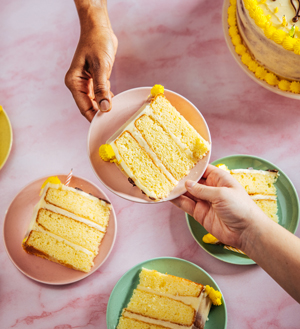Baking Pans
Some cakes require greasing and flouring the baking pan and some call for using parchment or waxed paper. To ensure the best results from every baking recipe, always prepare baking pans as instructed in the recipe or in the manufacturer’s directions. Common preparation steps include:
Greasing a baking pan
Use a pastry brush, paper towel, waxed paper, or fingertips to apply a thin, even layer of butter, margarine, or shortening to bottom and sides of the baking pan, as directed. As an alternative, coat the baking pan with non‐stick cooking spray. Softening shortening, butter, or margarine slightly in the microwave makes it easier to use a pastry brush.
Greasing and flouring a baking pan
Use a pastry brush, paper towel, or waxed paper to apply a thin, even layer of butter, margarine, or shortening to bottom and sides of the baking pan, as directed. Add 2 to 3 tablespoons flour to each baking pan. Tilt the baking pan slightly. Gently tap and rotate the pan until bottom and sides are evenly coated with flour. Invert the baking pan and tap bottom gently to remove excess flour. Gently tapping the sides of the greased baking pan helps distribute the flour.TIP: When a recipe for chocolate cakes calls for greasing and flouring the baking pan, use cocoa powder instead of flour. No more white spots on the surface of the baked cake!
Lining a baking pan with paper
Invert baking pan; place a sheet of parchment (or waxed paper) on top. Press all around the edge of the baking pan to form a crease in the paper. Cut out the paper along the crease. Grease the baking pan, but do not flour it. (Coating the bottom with non‐stick cooking spray is another option.) Press the paper into the bottom of the greased baking pan. Continue with the recipe, greasing and flouring the paper if so directed. Use fingertips to press paper firmly around bottom edge of the baking pan and make a crease.
Preparing a springform pan
Tear off a piece of heavy-duty foil that is at least 2 inches larger than the pan, all the way around. Line the bottom section of the pan with foil, tucking the edges under the bottom. Attach the rim, making sure it fits securely in the groove around the edge of the bottom. Untuck the excess foil and bring it up around the side of the pan; trim if necessary. Grease the foil-lined bottom and side of pan. All springform pans leak a little bit. Wrapping with foil prevents the batter from spilling out.
Preparing a Bundt pan
To prevent sticking, be sure all the creases and flutes of the pan are well greased (and floured, if recipe calls for it) before pouring in the batter. A pastry brush works well for greasing all the creases and curves of a Bundt pan.
It’s best to use the pan type and size specified in the recipe, but if you need to substitute a different pan, the following substitution options can help you get the best result. To determine a pan’s volume, measure the amount of water it takes to fill the pan.
Tips:
- To ensure a cake rises evenly, fill a pan only to its halfway mark.
- If you substitute a different baking pan than what’s specified in the recipe, it’s possible that the baking time could be different! It is imperative that you keep a watchful eye on your cake and check for doneness early on.
| Recipe Calls For | Volume | Substitutions | |||||||
|---|---|---|---|---|---|---|---|---|---|
| 1 (8-inch) round cake pan | 4 cups |
|
|||||||
| 2 (8-inch) round cake pans | 8 cups |
|
|||||||
| 1 (9-inch) round cake pan |
6 cups |
|
|||||||
| 2 (9-inch) round cake pans | 12 cups |
|
|||||||
| 1 (10-inch) round cake pan |
11 cups |
|
|||||||
| 2 (10-inch) round cake pans |
22 cups |
|
|||||||
| 9-inch tube pan | 12 cups |
|
|||||||
| 10-inch tube pan | 16 cups |
|
|||||||
| 10-inch Bundt pan | 12 cups |
|
|||||||
| 11 x 7 x 2-inch baking dish | 6 cups |
|
|||||||
| 9 x 13 x 2-inch baking dish | 15 cups |
|
|||||||
| 10 x 15 x 1-inch jellyroll pan | 15 cups |
|
|||||||
| 9 x 5-inch loaf pan | 8 cups |
|
|||||||
| 8 x 4-inch loaf pan | 6 cups |
|
|||||||
| 9-inch springform pan | 10 cups |
|
|||||||
| 10-inch springform pan | 12 cups |
|
|||||||
| 8-inch square baking dish | 8 cups |
|
|||||||
| 9-inch square baking dish | 8 cups |
|
|||||||
| Muffin Tins | |||||||||
| 1¾ x ¾ inches | ⅛ cup | ||||||||
| 2¾ x 1⅛ inches | ¼ cup | ||||||||
| 2¾ x 1½ inches | ½ cup | ||||||||
| 3 x 1¼ inches | ⅝ cup | ||||||||
| Heart Shaped | |||||||||
| 8 x 8½ inches | 8 cups |
Read the recipe carefully to make sure you have the type of baking pan that is called for. You also should be aware of the baking pan material, because it can affect the outcome. In general, glass baking dishes require a 25°F reduction in oven temperature. Some recipes may actually specify which material (metal or glass) will get the best results.
Often, you can determine what type of baking pan and what material will work best by carefully noting the description used in the recipe method. These general definitions usually apply:
- A baking dish is glass
- A baking pan is metal
- A pie plate is usually glass
- A pie pan is usually metal
- A baking sheet is a sided pan (15 x 10 x 1 inch)
- A cookie sheet has no sides
- A springform pan features two pieces: a bottom and a rim with a buckle for releasing cakes or tarts
- A tube pan is a deep, round metal pan with a hollow center tube
- A Bundt pan is a shallow tube pan that is curved and fluted for baking styled cakes.
- A tart pan is usually metal. Unlike a pie pan, it has straight sides (some fluted, some not) and many have a removable bottom.
- A silicone baking pan is made of highly flexible polymer. The material is non-stick; can withstand oven temperatures up to 500° Fahrenheit; and is safe for use in the freezer, microwave and dishwasher.

